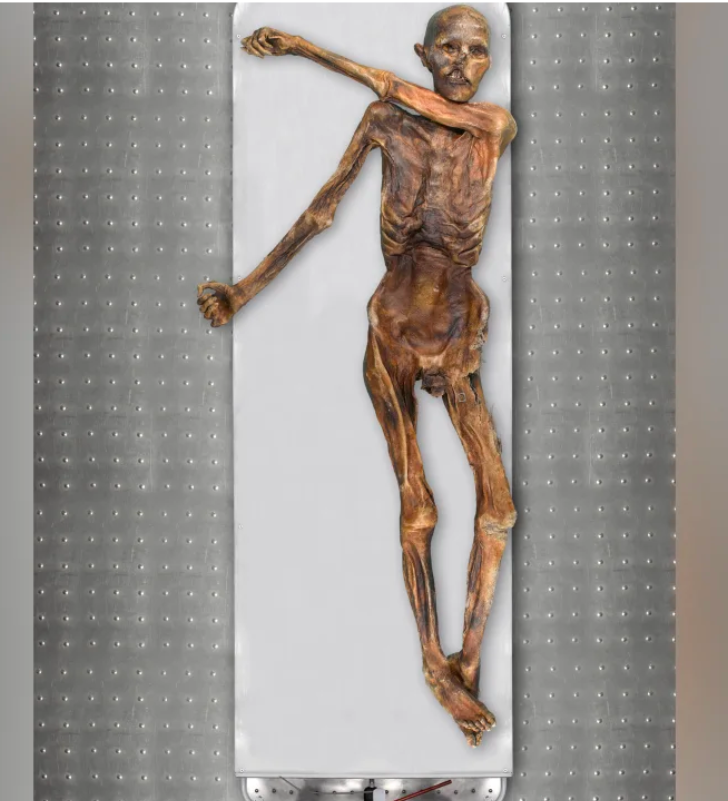Dobrý den, jmenuji se Ötzi,
Nejste vy ,takovej malej tlustej s brejlema 🤔 vždyť vidíte, že jsem štihlej a bez brejlí 🤷♂️😁
Jinak zajímavě zajímavý příspěvek 👍👍
Ötzi the Ice Man - he looked different and came from somewhere else. A new study disproves previous ideas
Categories: Nálezy nejenom s detektorem v západní Evropě
Ötzi's well-preserved body from the Copper Age between 3350 and 3120 BC was discovered by hikers in the Alps near the Austrian-Italian border in 1991. In 2012, the first DNA analysis found genetic traits of steppe herders from Eastern Europe in the mummy's ancestors. But the latest high-quality genetic analysis of DNA sequencing refutes the previous results. Ötzi was much closer to early Anatolian farmers. The study also provides completely different information about Ötzi's appearance.
According to the 2012 DNA study, he was thought to carry the genes of the steppe people of the so-called "Yama culture", who did not arrive in Europe until centuries after his death. A new study of better quality samples taken from the hip explains that the earlier result was probably due to contamination by contemporary human DNA and brings new information that fundamentally changes the view of the Ice Man. In fact, he had more than 92% Anatolian ancestry, farmers from what is now Turkey who did not interact much with their European hunter-gatherer contemporaries.
"Analysis of the genome revealed phenotypic traits such as high skin pigmentation, dark eye colour and male pattern baldness, which are in stark contrast to the previous"Evolutionary anthropologist Johannes Krause of the Max Planck Institute explained. "It is remarkable how the reconstruction has been distorted by our own preconceptions of European Stone Age man," he added.
"Until now, it was believed that his skin darkened during the mummification process," said Albert Zink, head of the Institute for Mummy Studies at Eurac Research, a private research centre based in Bolzano. "The dark colour of the mummy's skin seems to be quite close to the actual skin colour of the 'ice man' during his lifetime," added Zink, who is co-author of the research published in the scientific journal Cell Genomics.
"It's not so surprising that Ötzi was dark-skinned. Many Europeans at the time probably had darker pigmentation than most contemporaries. The first European farmers still had quite dark skin, which changed to lighter over time as they adapted to climate change and diet. Farmers consumed much less vitamin D in their diet compared to hunter-gatherers," Zinc explained, according to whichÖtzi consumed quite a lot of meat, which was also confirmed by the analysis of his stomach, in which the remains of ibex and deer were found.
"It doesn't completely change our knowledge of him, but some things are clearer now," Zinc further explained. "It turns out that the ice man most likely lived in a relatively isolated area with only limited contact with other populations and a low gene pool from hunter-gatherer populations," he added.
Almost every part of Ötzi and his belongings has been analysed, creating an interesting picture of his life 5,300 years ago. The contents of his stomach provided information about his last meal and where it came from, his weapons revealed he was right-handed and his clothing revealed what Stone Age people actually wore. Together, Zink's team hopes to uncover more details, such as the composition of Ötzi's microbiome.
Roman Nemec
Sources: cosmosmagazine.com, edition.cnn.com, cell.com

Ötzi's reconstruction at the South Tyrol Museum of Archaeology will have to be redone

The site of the Ice Man discovery

Map of relatives

Ötzi's mummy is the most studied mummy in the world

Wetting Otzi's body
The article is included in categories:
- Archive of articles > Archaeology > Finds and rescue research abroad > Nálezy nejenom s detektorem v západní Evropě
Post
Nakoniec sa možno zistí že to bol cigán na vandrovke.






